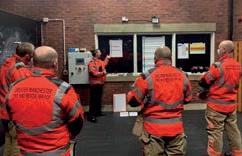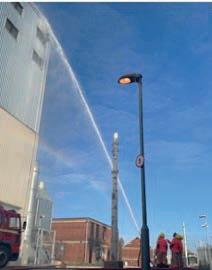
5 minute read
High Rise Fire Training Sessions at Bury Training and Safety Centre by Ian Redfern MJOIFF
by Catalyst
HIGH RISE FIRE TRAINING SESSIONS
AT BURY TRAINING AND SAFETY CENTRE
Advertisement
by Ian Redfern MJOIFF
Since the fire at Grenfell Tower, Greater Manchester Fire and Rescue Service (GMFRS) has continued to amend and develop operational procedures and training packages as part of a coordinated response to the recommendations of the Grenfell Tower Public Inquiry.
In addition, GMFRS is increasingly responding to larger, more protracted, more complex incidents such as The Cube fire in Bolton. GMFRS’ Built Environment Project has brought together a list of deliverables from the learning of both the Grenfell Tower Inquiry – Phase 1 report and The Cube Fire Incident Review. The project works with department heads ensuring that wherever possible activities are coordinated and cut across as many of the deliverables as possible, this training is a great example of this.
“It is now a reasonably foreseeable situation that our firefighters may be faced with a building that fails under fire conditions and therefore we have prioritised training for all our operational staff,” said Area Manager Ben Levy, Head of the Built Environment Project at GMFRS.
“That’s why developing this training has been essential to make sure we are all up to speed on the most effective techniques for tackling fires in blocks of flats and high-rise buildings. “These buildings present complex challenges to firefighters, due to their structure, the potential for fire spread and therefore the need to ensure that we seize a window of opportunity as soon as possible upon arrival at an incident to assess whether the building is performing as we would expect.”
The initial theory element of the training consisted of filmed presentations around topics including the Future of Greater Manchester’s built environment and the particular challenges of tall buildings.
Once completed, participants attended a practical session at Bury Training Centre, which covered five elements of dealing with fires in tall buildings such as the use of lifts, use of smoke curtains and the gas detector to monitor conditions in stairwells.
SESSION 1:
Immediate Building Evacuation (IBE) and evacuation unit familiarisation.
A Station Manager delivered training on what happens when an Incident Commander declares an IBE, what the IC can expect in support including an additional Command Unit as an Evacuation Unit.
All crews were given familiarisation on Fire Survival Guidance arrangements, specifically how the information comes from Fire Control, is logged and sorted on the Evacuation Unit and then sent on to the operational sectors on the incident ground
SESSION 2:
Premises Information Boxes (PIBs) and Firefighting Lifts.

The Greater Manchester High Rise Task Force is developing the idea of PIBs and have agreed in principle a standard set of information that is to be contained within them. Also during this session we explored the functions of lifts, as depending on what standard they are maintained to, will determine the available functions that will be available for our firefighters to use. At our Operational Training and Safety Centre in Bury, there is a fully
functioning lift with a ‘Fireman’s switch’, we used this to highlight that such a switch is probably at least 20 years out of date and may not have the functions they would expect. The overriding message to the fire crews from this session was to get out into the built environment within theirs station areas and check the PIBs have the right information in them and to test the lift’s functions.
SESSION 3:
Activities of Stairwell Protection Teams and the use of gas detectors.
A Hazardous Materials and Environmental Protection Officer (HMEPO) delivered training on the correct and effective use of gas detectors when crews are deployed as Stairwell protection Teams (SPTs). SPTs should not be a response to a building that is failing in fire, their deployment should be an early consideration by all ICs in order to seize the window of opportunity to ensure and maintain the tenability of the means of escape (stairwell). Their main tasks are to keep the stairwells as safe as possible, monitoring their Gas detectors and fitting smoke curtains on doors to stairwells to prevent smoke spread, keeping stairwells clear of firefighting equipment where possible and to guide and assist any residents that want to evacuate the building. Rescue Intervention Containment Evacuation (RICE) Principles. The RICE tool is new to GMFRS, in this session we discussed the priority of actions so that BA crews and initial Incident Commanders can decide where to deploy Smoke Curtains, whether to evacuate other flats on the fire floor, or to enter the flat that is on fire and intervene. In the instances where we know the occupants of the flat are safely outside, the crews may decide to evacuate the other residents on that floor before they make entry and fight the fire.
SESSION 5:
External fire attack and Cleveland Roll demonstration session.


Externally the fire crews observed the ground monitor in action and are introduced to the Cleveland roll, a method of stowing 52mm High rise Hose which enables quick deployment and reduces obstructions on stairwells.
This training was well received by crews, they recognised the value of this training and feel it was worthwhile even though there were concerns that, with the National lockdown due to COVID 19, the training might be postponed. However, the Operational Training Team overcame significant challenges and structured the sessions in such a way that crews stayed in their own “bubbles” and moved around the site from session to session safely.
We invited officers from across the North West Region of the United Kingdom to come and observe what we are doing, and we have created video recordings of each of the training sessions so that they can be used for eLearning packages for refresher training, but also so that we can share what we have done with other services.
Fires in tall buildings can be complex, especially when compartmentation fails and the problems this causes to our fire crews and residents are multi-faceted. It is our view that no single Fire and Rescue Service is going to be able to solve all of these problems, so it is vitally important that we all share our learning and work collaboratively.”
EDITOR’S NOTE:
The July edition of The Catalyst will have an article on The Cube fire. Ian Redfern MJOIFF is a Group Manager with Greater Manchester Fire and Rescue Service working on the Built Environment project and is also the service’s Lead Petrochemical Officer. For further information on this project contact email: redferni@manchesterfire. gov.uk










